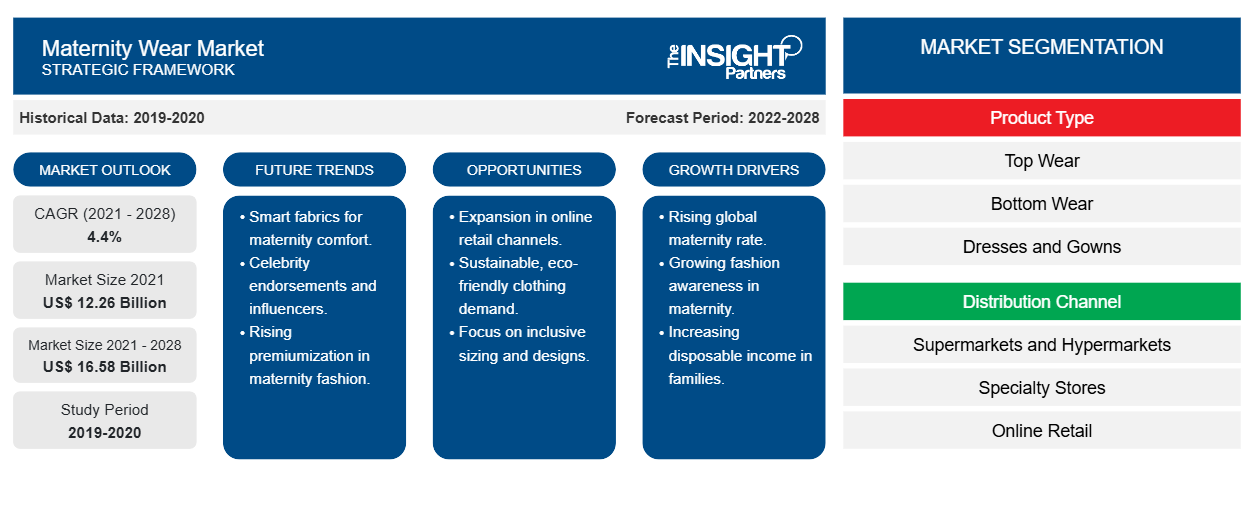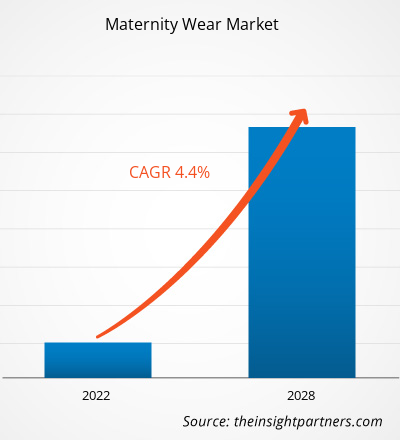マタニティウェア市場は2021年に122億5,741万米ドルと評価され、2028年までに165億7,864万米ドルに達すると予測されており、2021年から2028年にかけて4.4%のCAGRで成長すると予想されています。
マタニティウェアは通常、ゴム、タブ、エラスタンやスパンデックスなどの伸縮性のある生地を使用したゆったりとした適切なフィット感で作られており、妊娠中の消費者にさらなる快適さを提供します。
アジア太平洋地域は2020年に世界のマタニティウェア市場で最大のシェアを占めましたが、北米は予測期間中に最高のCAGRを記録すると予想されています。世界銀行のレポートによると、米国では平均85%の妊娠中の女性が働いています。そのため、フォーマルドレスやガウンのセクションでは、マタニティウェアやフォーマルウェアのプラスサイズの需要が高まっています。これが北米のマタニティウェア市場の成長に貢献する主な要因です。
COVID-19パンデミックがマタニティウェア市場に与える影響
COVID-19パンデミックは、消費財業界を含む多くの業界に悪影響を及ぼしています。パンデミックは、ロックダウン、事業停止、サプライチェーンの混乱により、運営上の困難を引き起こしました。衣料品およびアパレル小売店は、売上高の大きな損失を記録しました。スペインのインディテックスグループやスウェーデンのH&Mなどのファッションブランドが発表した財務結果は、パンデミックの影響の大きさを明らかにしました。さらに、ほとんどのオンライン購入者がパンデミック後の選択肢として電子小売を検討しているため、eコマースはパンデミックから長期的な利益を経験しました。さらに、ワクチン接種率の上昇、製造活動の復活、政府規制の緩和は、予測期間中に世界のマタニティウェア市場にプラスの影響を与えると予測されています。
要件に合わせてレポートをカスタマイズする
このレポートの一部、国レベルの分析、Excelデータパックなど、あらゆるレポートを無料でカスタマイズできます。また、スタートアップや大学向けのお得なオファーや割引もご利用いただけます。
- このレポートの主要な市場動向を入手してください。この無料サンプルには、市場動向から見積もりや予測に至るまでのデータ分析が含まれます。
市場分析
ビジネス成長戦略の採用が市場の成長を促進
市場で確立されたプレーヤーは、企業の拡大における現在および将来の課題を克服するために、さまざまな戦略を採用しています。たとえば、Isabella Oliverは、リーチを向上させるためにマタニティウェアのレンタルプログラムを開始することで、市場浸透戦略を採用しました。2020年1月20日、同ブランドは循環型になり、マタニティウェアの寿命を延ばすために、再び新しいレンタルプログラムを開始しました。Isabella Oliverは、パーティーウェアや妊娠中の基本的な必需品を含むドレスを2週間無料でレンタルできる新しいオプションを顧客に提供しました。同ブランドはドライクリーニングも行います。顧客は製品を購入することもできます。マタニティウェアをレンタルするという考えは、顧客に環境に配慮し、ファストファッションの影響を排除するよう促すことです。したがって、製品の革新と浸透は、マタニティウェアの需要の増加につながりました。これらの要因がマタニティアパレル市場の成長を牽引しています。
流通チャネルの洞察
流通チャネルに基づいて、マタニティウェア市場は、スーパーマーケットとハイパーマーケット、専門店、オンライン小売、その他に分類されます。オンライン小売セグメントは、予測期間中に最高のCAGRを記録すると予想されます。COVID-19パンデミックの最初の数か月間は、物理的な小売店の営業が許可されなかったため、電子商取引が重要な役割を果たしました。ロックダウン中、人々はますます電子商取引プラットフォームを使用して、必需品と非必需品を購入していました。COVID-19の発生による経済危機により、女性の可処分所得は減少しました。しかし、マタニティウェアの需要は影響を受けませんでした。その結果、競争力のある価格設定は、将来的に全体的な状況の重要な特徴になる可能性があります。この要因は、予測期間中にオンライン小売セグメントの市場成長を潜在的に強化すると予測されています。
製品タイプの洞察
製品タイプに基づいて、マタニティウェア市場は、トップス、ボトムス、ドレスとガウン、インナーウェアに分類されます。トップスセグメントは2020年に大きな市場シェアを占め、ドレスとガウンセグメントは予測期間中に高いCAGRを記録すると予想されます。マタニティトップスウェアの生地は、フォーマルウェアとカジュアルウェアで構成されています。さらに、働く女性の増加により、フォーマルなマタニティウェアの需要が高まっています。フォーマルなマタニティトップスウェアは、クルティ、ブラウス、柔らかい素材のタンクトップドレス、ブレザー、二重層のトレンチコートで構成されています。カジュアルウェアは、チュニック、マキシドレス、オーバーサイズのスウェットシャツとTシャツで構成されています。マタニティウェアは、柔らかく安定した呼吸を可能にするため、綿、モダール、竹などの自然で快適な素材を使用した最高品質の生地で作られています。妊婦は季節の変化に応じて素材を選ぶ傾向があります。夏には通気性の良い、熱をはじくリネン生地が好まれ、冬には寒さを防ぐ暖かいウールのコートが好まれます。
マタニティウェア市場で事業を展開している企業としては、Gap Inc、Seraphine、Isabella Oliver、H and M Hennes and Mauritz AB、Brunelli and Co SRL、Mothercare、Boob Design、SHAICO Fashion Pvt. Ltd、Pink Blush Maternity、Organic & More などがあります。
マタニティウェア市場の地域別分析
予測期間を通じてマタニティウェア市場に影響を与える地域的な傾向と要因は、Insight Partners のアナリストによって徹底的に説明されています。このセクションでは、北米、ヨーロッパ、アジア太平洋、中東、アフリカ、南米、中米にわたるマタニティウェア市場のセグメントと地理についても説明します。

- マタニティウェア市場の地域別データを入手
マタニティウェア市場レポートの範囲
| レポート属性 | 詳細 |
|---|---|
| 2021年の市場規模 | 122.6億米ドル |
| 2028年までの市場規模 | 165.8億米ドル |
| 世界のCAGR(2021年~2028年) | 4.4% |
| 履歴データ | 2019-2020 |
| 予測期間 | 2022-2028 |
| 対象セグメント | 製品タイプ別
|
| 対象地域と国 | 北米
|
| 市場リーダーと主要企業プロフィール |
|
市場プレーヤーの密度:ビジネスダイナミクスへの影響を理解する
マタニティウェア市場は、消費者の嗜好の変化、技術の進歩、製品の利点に対する認識の高まりなどの要因により、エンドユーザーの需要が高まり、急速に成長しています。需要が高まるにつれて、企業は提供品を拡大し、消費者のニーズを満たすために革新し、新たなトレンドを活用し、市場の成長をさらに促進しています。
市場プレーヤー密度とは、特定の市場または業界内で活動している企業または会社の分布を指します。これは、特定の市場スペースに、その市場規模または総市場価値に対してどれだけの競合相手 (市場プレーヤー) が存在するかを示します。
マタニティウェア市場で事業を展開している主要企業は次のとおりです。
- ギャップ株式会社
- セラフィン
- イザベラ・オリバー
- H&M ヘネス・アンド・マウリッツ
- ブルネリ&カンパニーSRL
免責事項:上記の企業は、特定の順序でランク付けされていません。

- マタニティウェア市場のトップキープレーヤーの概要を入手
レポートの注目点
- マタニティウェア市場における進歩的な業界動向は、プレーヤーが効果的な長期戦略を策定するのに役立ちます。
- 先進国市場と発展途上国市場で採用されているビジネス成長戦略
- 2019年から2028年までのマタニティウェア市場の定量分析
- 乳製品原料の世界需要の推定
- 業界で活動するバイヤーとサプライヤーの有効性を示すポーターの5つの力の分析
- 競争市場の状況を理解するための最近の動向
- マタニティウェア市場の成長を牽引・抑制する要因と市場動向と展望
- 商業的利益の基盤となる市場戦略を強調し、市場の成長につながる意思決定プロセスを支援する
- さまざまなノードにおけるマタニティウェア市場規模
- 市場の詳細な概要とセグメンテーション、およびマタニティウェア業界の動向
- 有望な成長機会のあるさまざまな地域のマタニティウェア市場の規模
- 過去2年間の分析、基準年、CAGRによる予測(7年間)
- PEST分析とSWOT分析
- 市場規模価値/数量 - 世界、地域、国
- 業界と競争環境
- Excel データセット


- Online Exam Proctoring Market
- Carbon Fiber Market
- Wire Harness Market
- Europe Surety Market
- Single-Use Negative Pressure Wound Therapy Devices Market
- Authentication and Brand Protection Market
- Emergency Department Information System (EDIS) Market
- Occupational Health Market
- Sports Technology Market
- Energy Recovery Ventilator Market

Report Coverage
Revenue forecast, Company Analysis, Industry landscape, Growth factors, and Trends

Segment Covered
This text is related
to segments covered.

Regional Scope
North America, Europe, Asia Pacific, Middle East & Africa, South & Central America

Country Scope
This text is related
to country scope.
よくある質問
The global maternity wear market is driven by the rising number of pregnant working women coupled with the adoption of business growth strategies by the market players.
Based on distribution channel, the supermarkets and hypermarkets segment held the largest market share in 2020. Supermarkets and hypermarkets, considered as an effective distribution channel, are large retail stores that offer a wide range of maternity clothes. Many leading manufacturers of maternity clothes target selling their products through prominent supermarkets and hypermarkets chains, such as Mom & Baby, Mother Care, and FirstCry, as there is high customer traffic in these stores. This factor is also driving the popularity of supermarkets and hypermarkets for purchasing maternity clothes.
Top wear accounted for a major share in 2020. Maternity top-wear cloth consists of formal wear and casual wear. The demand for formal maternity top wear is rising due to the increasing number of working females. Formal maternity top-wear consists of kurtis, blouses, soft material tank dresses, blazers, and trench coats with double layers, and casual wear comprises tunics, maxi dresses, and oversize sweatshirts and t-shirts.
The major players operating in the global maternity wear market are Gap Inc, Seraphine, Isabella Oliver, H & M Hennes and Maurits, Brunelli & Co. S.R.L., Mothercare, Boob Design, Pinkblush Maternity, Adidas America Inc., and Organic and More among others.
In 2020, Asia Pacific held the largest share in the global maternity wear market. Asia-Pacific continent comprises several developing and developed economies such as India, China, Japan, South Korea, and Australia. These emerging countries are witnessing an increase in spending by new mothers to be over their first pregnancy photo-shoots, accompanied by growing purchasing capacity of women in this region.
Trends and growth analysis reports related to Consumer Goods : READ MORE..
The List of Companies - Maternity Wear Market
- Gap Inc
- Seraphine
- Isabella Oliver
- H & M Hennes and Maurits
- Brunelli & Co. S.R.L
- Mothercare
- Boob Design
- Shaico Design Pvt. Ltd.
- Pinkblush Maternity
- Organic & More
The Insight Partners performs research in 4 major stages: Data Collection & Secondary Research, Primary Research, Data Analysis and Data Triangulation & Final Review.
- Data Collection and Secondary Research:
As a market research and consulting firm operating from a decade, we have published and advised several client across the globe. First step for any study will start with an assessment of currently available data and insights from existing reports. Further, historical and current market information is collected from Investor Presentations, Annual Reports, SEC Filings, etc., and other information related to company’s performance and market positioning are gathered from Paid Databases (Factiva, Hoovers, and Reuters) and various other publications available in public domain.
Several associations trade associates, technical forums, institutes, societies and organization are accessed to gain technical as well as market related insights through their publications such as research papers, blogs and press releases related to the studies are referred to get cues about the market. Further, white papers, journals, magazines, and other news articles published in last 3 years are scrutinized and analyzed to understand the current market trends.
- Primary Research:
The primarily interview analysis comprise of data obtained from industry participants interview and answers to survey questions gathered by in-house primary team.
For primary research, interviews are conducted with industry experts/CEOs/Marketing Managers/VPs/Subject Matter Experts from both demand and supply side to get a 360-degree view of the market. The primary team conducts several interviews based on the complexity of the markets to understand the various market trends and dynamics which makes research more credible and precise.
A typical research interview fulfils the following functions:
- Provides first-hand information on the market size, market trends, growth trends, competitive landscape, and outlook
- Validates and strengthens in-house secondary research findings
- Develops the analysis team’s expertise and market understanding
Primary research involves email interactions and telephone interviews for each market, category, segment, and sub-segment across geographies. The participants who typically take part in such a process include, but are not limited to:
- Industry participants: VPs, business development managers, market intelligence managers and national sales managers
- Outside experts: Valuation experts, research analysts and key opinion leaders specializing in the electronics and semiconductor industry.
Below is the breakup of our primary respondents by company, designation, and region:

Once we receive the confirmation from primary research sources or primary respondents, we finalize the base year market estimation and forecast the data as per the macroeconomic and microeconomic factors assessed during data collection.
- Data Analysis:
Once data is validated through both secondary as well as primary respondents, we finalize the market estimations by hypothesis formulation and factor analysis at regional and country level.
- Macro-Economic Factor Analysis:
We analyse macroeconomic indicators such the gross domestic product (GDP), increase in the demand for goods and services across industries, technological advancement, regional economic growth, governmental policies, the influence of COVID-19, PEST analysis, and other aspects. This analysis aids in setting benchmarks for various nations/regions and approximating market splits. Additionally, the general trend of the aforementioned components aid in determining the market's development possibilities.
- Country Level Data:
Various factors that are especially aligned to the country are taken into account to determine the market size for a certain area and country, including the presence of vendors, such as headquarters and offices, the country's GDP, demand patterns, and industry growth. To comprehend the market dynamics for the nation, a number of growth variables, inhibitors, application areas, and current market trends are researched. The aforementioned elements aid in determining the country's overall market's growth potential.
- Company Profile:
The “Table of Contents” is formulated by listing and analyzing more than 25 - 30 companies operating in the market ecosystem across geographies. However, we profile only 10 companies as a standard practice in our syndicate reports. These 10 companies comprise leading, emerging, and regional players. Nonetheless, our analysis is not restricted to the 10 listed companies, we also analyze other companies present in the market to develop a holistic view and understand the prevailing trends. The “Company Profiles” section in the report covers key facts, business description, products & services, financial information, SWOT analysis, and key developments. The financial information presented is extracted from the annual reports and official documents of the publicly listed companies. Upon collecting the information for the sections of respective companies, we verify them via various primary sources and then compile the data in respective company profiles. The company level information helps us in deriving the base number as well as in forecasting the market size.
- Developing Base Number:
Aggregation of sales statistics (2020-2022) and macro-economic factor, and other secondary and primary research insights are utilized to arrive at base number and related market shares for 2022. The data gaps are identified in this step and relevant market data is analyzed, collected from paid primary interviews or databases. On finalizing the base year market size, forecasts are developed on the basis of macro-economic, industry and market growth factors and company level analysis.
- Data Triangulation and Final Review:
The market findings and base year market size calculations are validated from supply as well as demand side. Demand side validations are based on macro-economic factor analysis and benchmarks for respective regions and countries. In case of supply side validations, revenues of major companies are estimated (in case not available) based on industry benchmark, approximate number of employees, product portfolio, and primary interviews revenues are gathered. Further revenue from target product/service segment is assessed to avoid overshooting of market statistics. In case of heavy deviations between supply and demand side values, all thes steps are repeated to achieve synchronization.
We follow an iterative model, wherein we share our research findings with Subject Matter Experts (SME’s) and Key Opinion Leaders (KOLs) until consensus view of the market is not formulated – this model negates any drastic deviation in the opinions of experts. Only validated and universally acceptable research findings are quoted in our reports.
We have important check points that we use to validate our research findings – which we call – data triangulation, where we validate the information, we generate from secondary sources with primary interviews and then we re-validate with our internal data bases and Subject matter experts. This comprehensive model enables us to deliver high quality, reliable data in shortest possible time.


 このレポートの無料サンプルを入手する
このレポートの無料サンプルを入手する